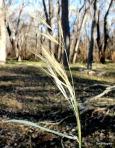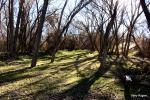Outdoor Recreation Aids Plant Invasions
 Outdoor recreation does far more than simply transport invasive plants. It disturbs soils and vegetation and takes the lives of animals. Leopold commented on the most violent type of recreation:
Outdoor recreation does far more than simply transport invasive plants. It disturbs soils and vegetation and takes the lives of animals. Leopold commented on the most violent type of recreation:
“The disquieting thing is the trophy hunter who never grows up. … To enjoy he must invade, possess, appropriate. Hence the wilderness that he cannot personally see has no value to him. Hence the universal assumption that an unused hinterland is rendering no service to society” (Leopold 1949: 176).
Land managers and planners view outdoor recreation as a psychological and physiological benefit for people, and as an economic enterprise that benefits local business. They oppose invasion by foreign plants because they reduce the benefits (e.g., Eiswerth et al. 2005), and they often spray herbicides without restraint.
 Ripgut Brome Grass (Bromus diandrus), is an African invasive plant that has taken over one of my pastures. Ripgut has some of the most painful burrowing seeds you will ever meet. Once the seeds form, as in the photo at left, a left over from warmer months, cows and most other animals avoid the plant.
Ripgut Brome Grass (Bromus diandrus), is an African invasive plant that has taken over one of my pastures. Ripgut has some of the most painful burrowing seeds you will ever meet. Once the seeds form, as in the photo at left, a left over from warmer months, cows and most other animals avoid the plant.
.

Ripgut in January awaiting spring beneath Cottonwood and Willow along the Agua Fria River in central Arizona
I stopped using the pasture years ago. Now I let it be a quiet place for wildlife. I know Ripgut has little wildlife value, but I don’t have the labor force needed to pull it, and the pasture is too rocky for mowing. I don’t use herbicides. Though the grass reduces the pasture’s wildlife value, there are cottonwood trees and willow thickets that some animals use regularly. So I discourage hikers and motorists and tell all that will listen that the river pasture is one of those rare habitat gems where water and thick vegetation support the lives of many wild animals. Recently, I spotted a hiker and his dog in the pasture. I had previously explained to this particular person that I was discouraging hikers to create a quiet habitat for wildlife. Apparently that message had no meaning for him. As the man’s dog dove into a pond and routed the last ducks bravely ignoring his presence, the man complained to me that Ripgut had reduced the value of my pasture for his use. He would make a perfect recreation planner.
The man’s attitude agrees with most nature conservationists who take the homocentric view that nature’s value is determined by human desires. Sadly, the bulk of conservation research and opinion is rooted in this belief. Thus, humans trying to preserve nature solely for the benefit of nature are mistakenly labeled extremists or lunatics.
Homocentrically speaking, recreation is a form of resource use that varies from low-intensity activities such as viewing and photographing, to high-intensity activities such as hiking, hunting, and motorized sports. The frequency of any type of activity influences its homocentric sustainability. Thus, occasional visits by small numbers of people hiking through a wilderness area will not reduce the scenic value of the ecosystem as completely as continuous visits or livestock grazing.
This doesn’t mean that land mangers zealously defend those scenic values. Over decades of visiting favored sites, I have seen small paths grow to broad beaten tracks devoid of life. With time, the tracks sprout branches that create a web of paths that are often only meters apart. Along the paths, the soils and animal/plant communities deteriorate, and invasive plants spread. Here are some thoughts on managing recreation to decrease the spread of invasive plants.
Eleven Strategies to Minimize Recreation Caused Plant Invasions
- Provide signs that explain the damage caused by invasive plants, for education is the best hope.
- Insure that trail users understand how to avoid weed transport.
- Provide local invasive plant field guides.
- Limit trails to existing human corridors. Reroute corridors away from critical habitats such as lower-valley stream-side vegetation.
- Provide clearly marked camp sites near human corridors.
- Reduce roads, trails, and access to burned, overgrazed, and construction sites.
- Reduce access to riparian and sand dune landscapes.
- Avoid low-resiliency BSC sites (Belnap et al. 2001).
- Promote hiking and backpacking during late fall and winter periods, preferably when soils are frozen. Restrict access during dry seasons when BSCs are most sensitive.
- Prevent off-road driving and new trail formation by fencing roads—provide frequent parking locations.
- Where possible, rotate use areas and plan for long recovery periods for BSCs. “…greater than 10 years minimum on moderate-to high-resiliency sites” (Belnap et al. 2001). It can take a century for low-resiliency sites to recover.
References
Belnap, J., J. H. Kaltenecker, R. Rosentreter, J. Williams, S. Leonard, and D. Eldridge. 2001. Biological soil crusts: Ecology and management. USDI BLM Tech Ref 1730-2. 111 p.
Eiswerth, M.E., W.S. Johnson, J. Agapoff, T.D. Darden, T.R. Harris. 2005. Economic Impacts from the Effects of Invasive Weeds on Outdoor Recreation: An Input-Output Model. University of Nevada, Reno, Special Publication 05-06. 6 p.
Leopold, A. 1949. A Sand County almanac and sketches here and there. Oxford University Press, New York. 226 p.
Google+
 Garry Rogers
Garry Rogers

